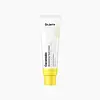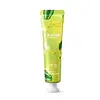What's inside
What's inside
 Key Ingredients
Key Ingredients

 Benefits
Benefits

 Concerns
Concerns

 Ingredients Side-by-side
Ingredients Side-by-side

Water
Skin ConditioningCaprylic/Capric Triglyceride
MaskingButylene Glycol
HumectantGlycerin
HumectantBehenyl Alcohol
EmollientPentylene Glycol
Skin ConditioningButyrospermum Parkii Butter
Skin ConditioningCetearyl Alcohol
Emollient1,2-Hexanediol
Skin ConditioningPanthenol
Skin ConditioningCaprylic/Capric/Myristic/Stearic Triglyceride
EmollientVinyldimethicone
Theobroma Cacao Extract
Skin ConditioningCetearyl Olivate
Caprylyl Glycol
EmollientCeramide NP
Skin ConditioningC14-22 Alcohols
Emulsion StabilisingC12-16 Alcohols
EmollientHydroxyethyl Acrylate/Sodium Acryloyldimethyl Taurate Copolymer
Emulsion StabilisingPalmitic Acid
EmollientHydrogenated Lecithin
EmulsifyingAcrylates/C10-30 Alkyl Acrylate Crosspolymer
Emulsion StabilisingSorbitan Olivate
EmulsifyingC12-20 Alkyl Glucoside
EmulsifyingTromethamine
BufferingDextrin
AbsorbentSorbitan Isostearate
EmulsifyingParfum
MaskingSodium Phytate
CI 19140
Cosmetic ColorantWater, Caprylic/Capric Triglyceride, Butylene Glycol, Glycerin, Behenyl Alcohol, Pentylene Glycol, Butyrospermum Parkii Butter, Cetearyl Alcohol, 1,2-Hexanediol, Panthenol, Caprylic/Capric/Myristic/Stearic Triglyceride, Vinyldimethicone, Theobroma Cacao Extract, Cetearyl Olivate, Caprylyl Glycol, Ceramide NP, C14-22 Alcohols, C12-16 Alcohols, Hydroxyethyl Acrylate/Sodium Acryloyldimethyl Taurate Copolymer, Palmitic Acid, Hydrogenated Lecithin, Acrylates/C10-30 Alkyl Acrylate Crosspolymer, Sorbitan Olivate, C12-20 Alkyl Glucoside, Tromethamine, Dextrin, Sorbitan Isostearate, Parfum, Sodium Phytate, CI 19140
Water
Skin ConditioningGlycerin
HumectantParaffinum Liquidum
EmollientCetyl Alcohol
EmollientDipropylene Glycol
HumectantPolysorbate 60
EmulsifyingGlyceryl Stearate
EmollientPEG-100 Stearate
Stearyl Alcohol
EmollientPhenoxyethanol
PreservativeCyclopentasiloxane
EmollientDimethicone
EmollientParfum
MaskingChlorphenesin
AntimicrobialMyristyl Alcohol
EmollientSorbitan Stearate
EmulsifyingAcrylates/C10-30 Alkyl Acrylate Crosspolymer
Emulsion StabilisingButyrospermum Parkii Butter
Skin ConditioningErythritol
HumectantSqualane
EmollientLauryl Alcohol
EmollientDisodium EDTA
Xanthan Gum
EmulsifyingBenzyl Alcohol
PerfumingPotassium Hydroxide
BufferingAdenosine
Skin ConditioningMusa Sapientum Fruit Extract
Skin ConditioningAlcohol
AntimicrobialPanthenol
Skin ConditioningCentella Asiatica Extract
CleansingVaccinium Angustifolium Fruit Extract
Skin ProtectingCoco-Caprylate/Caprate
EmollientTris(Tetramethylhydroxypiperidinol)Citrate
StabilisingEugenol
PerfumingLinalool
PerfumingCitronellol
PerfumingHexyl Cinnamal
PerfumingCitral
PerfumingBenzyl Salicylate
PerfumingLimonene
PerfumingPrunus Armeniaca Kernel Oil
MaskingVitis Vinifera Seed Oil
Emollient1,2-Hexanediol
Skin ConditioningButylene Glycol
HumectantCitric Acid
BufferingCitrus Paradisi Seed Oil
PerfumingMangifera Indica Seed Oil
EmollientPentylene Glycol
Skin ConditioningPunica Granatum Seed Oil
EmollientSolanum Lycopersicum Seed Oil
EmollientHoney Extract
HumectantCaprylyl Glycol
EmollientButyrospermum Parkii Butter Extract
Skin ConditioningEthylhexylglycerin
Skin ConditioningTocopherol
AntioxidantWater, Glycerin, Paraffinum Liquidum, Cetyl Alcohol, Dipropylene Glycol, Polysorbate 60, Glyceryl Stearate, PEG-100 Stearate, Stearyl Alcohol, Phenoxyethanol, Cyclopentasiloxane, Dimethicone, Parfum, Chlorphenesin, Myristyl Alcohol, Sorbitan Stearate, Acrylates/C10-30 Alkyl Acrylate Crosspolymer, Butyrospermum Parkii Butter, Erythritol, Squalane, Lauryl Alcohol, Disodium EDTA, Xanthan Gum, Benzyl Alcohol, Potassium Hydroxide, Adenosine, Musa Sapientum Fruit Extract, Alcohol, Panthenol, Centella Asiatica Extract, Vaccinium Angustifolium Fruit Extract, Coco-Caprylate/Caprate, Tris(Tetramethylhydroxypiperidinol)Citrate, Eugenol, Linalool, Citronellol, Hexyl Cinnamal, Citral, Benzyl Salicylate, Limonene, Prunus Armeniaca Kernel Oil, Vitis Vinifera Seed Oil, 1,2-Hexanediol, Butylene Glycol, Citric Acid, Citrus Paradisi Seed Oil, Mangifera Indica Seed Oil, Pentylene Glycol, Punica Granatum Seed Oil, Solanum Lycopersicum Seed Oil, Honey Extract, Caprylyl Glycol, Butyrospermum Parkii Butter Extract, Ethylhexylglycerin, Tocopherol
Ingredients Explained
These ingredients are found in both products.
Ingredients higher up in an ingredient list are typically present in a larger amount.
1,2-Hexanediol is a synthetic liquid and another multi-functional powerhouse.
It is a:
- Humectant, drawing moisture into the skin
- Emollient, helping to soften skin
- Solvent, dispersing and stabilizing formulas
- Preservative booster, enhancing the antimicrobial activity of other preservatives
Acrylates/C10-30 Alkyl Acrylate Crosspolymer is a synthetic polymer. It is used to thicken and improve the texture of products. Due to its properties, it can prevent water and oil ingredients from separating.
Butylene Glycol (or BG) is used within cosmetic products for a few different reasons:
Overall, Butylene Glycol is a safe and well-rounded ingredient that works well with other ingredients.
Though this ingredient works well with most skin types, some people with sensitive skin may experience a reaction such as allergic rashes, closed comedones, or itchiness.
Learn more about Butylene GlycolThis ingredient is also known as shea butter. It is an effective skin hydrator and emollient.
Emollients help soothe and soften your skin. It does this by creating a protective film on your skin. This barrier helps trap moisture and keeps your skin hydrated. Emollients may be effective at treating dry or itchy skin.
Shea butter is rich in antioxidants. Antioxidants help fight free-radicals, or molecules that may harm the body. It is also full of fatty acids including stearic acid and linoleic acid. These acids help replenish the skin and keep skin moisturized.
While Shea Butter has an SPF rating of about 3-4, it is not a sunscreen replacement.
Shea butter may not be fungal acne safe. We recommend speaking with a professional if you have any concerns.
Learn more about Butyrospermum Parkii ButterCaprylyl Glycol is a humectant and emollient, meaning it attracts and preserves moisture.
It is a common ingredient in many products, especially those designed to hydrate skin. The primary benefits are retaining moisture, skin softening, and promoting a healthy skin barrier.
Though Caprylyl Glycol is an alcohol derived from fatty acids, it is not the kind that can dry out skin.
This ingredient is also used as a preservative to extend the life of products. It has slight antimicrobial properties.
Learn more about Caprylyl GlycolGlycerin is already naturally found in your skin. It helps moisturize and protect your skin.
A study from 2016 found glycerin to be more effective as a humectant than AHAs and hyaluronic acid.
As a humectant, it helps the skin stay hydrated by pulling moisture to your skin. The low molecular weight of glycerin allows it to pull moisture into the deeper layers of your skin.
Hydrated skin improves your skin barrier; Your skin barrier helps protect against irritants and bacteria.
Glycerin has also been found to have antimicrobial and antiviral properties. Due to these properties, glycerin is often used in wound and burn treatments.
In cosmetics, glycerin is usually derived from plants such as soybean or palm. However, it can also be sourced from animals, such as tallow or animal fat.
This ingredient is organic, colorless, odorless, and non-toxic.
Glycerin is the name for this ingredient in American English. British English uses Glycerol/Glycerine.
Learn more about GlycerinPanthenol is a common ingredient that helps hydrate and soothe the skin. It is found naturally in our skin and hair.
There are two forms of panthenol: D and L.
D-panthenol is also known as dexpanthenol. Most cosmetics use dexpanthenol or a mixture of D and L-panthenol.
Panthenol is famous due to its ability to go deeper into the skin's layers. Using this ingredient has numerous pros (and no cons):
Like hyaluronic acid, panthenol is a humectant. Humectants are able to bind and hold large amounts of water to keep skin hydrated.
This ingredient works well for wound healing. It works by increasing tissue in the wound and helps close open wounds.
Once oxidized, panthenol converts to pantothenic acid. Panthothenic acid is found in all living cells.
This ingredient is also referred to as pro-vitamin B5.
Learn more about PanthenolParfum is a catch-all term for an ingredient or more that is used to give a scent to products.
Also called "fragrance", this ingredient can be a blend of hundreds of chemicals or plant oils. This means every product with "fragrance" or "parfum" in the ingredients list is a different mixture.
For instance, Habanolide is a proprietary trade name for a specific aroma chemical. When used as a fragrance ingredient in cosmetics, most aroma chemicals fall under the broad labeling category of “FRAGRANCE” or “PARFUM” according to EU and US regulations.
The term 'parfum' or 'fragrance' is not regulated in many countries. In many cases, it is up to the brand to define this term.
For instance, many brands choose to label themselves as "fragrance-free" because they are not using synthetic fragrances. However, their products may still contain ingredients such as essential oils that are considered a fragrance by INCI standards.
One example is Calendula flower extract. Calendula is an essential oil that still imparts a scent or 'fragrance'.
Depending on the blend, the ingredients in the mixture can cause allergies and sensitivities on the skin. Some ingredients that are known EU allergens include linalool and citronellol.
Parfum can also be used to mask or cover an unpleasant scent.
The bottom line is: not all fragrances/parfum/ingredients are created equally. If you are worried about fragrances, we recommend taking a closer look at an ingredient. And of course, we always recommend speaking with a professional.
Learn more about ParfumPentylene glycol is typically used within a product to thicken it. It also adds a smooth, soft, and moisturizing feel to the product. It is naturally found in plants such as sugar beets.
The hydrophilic trait of Pentylene Glycol makes it a humectant. As a humectant, Pentylene Glycol helps draw moisture from the air to your skin. This can help keep your skin hydrated.
This property also makes Pentylene Glycol a great texture enhancer. It can also help thicken or stabilize a product.
Pentylene Glycol also acts as a mild preservative and helps to keep a product microbe-free.
Some people may experience mild eye and skin irritation from Pentylene Glycol. We always recommend speaking with a professional about using this ingredient in your routine.
Pentylene Glycol has a low molecular weight and is part of the 1,2-glycol family.
Learn more about Pentylene GlycolWater. It's the most common cosmetic ingredient of all. You'll usually see it at the top of ingredient lists, meaning that it makes up the largest part of the product.
So why is it so popular? Water most often acts as a solvent - this means that it helps dissolve other ingredients into the formulation.
You'll also recognize water as that liquid we all need to stay alive. If you see this, drink a glass of water. Stay hydrated!
Learn more about Water